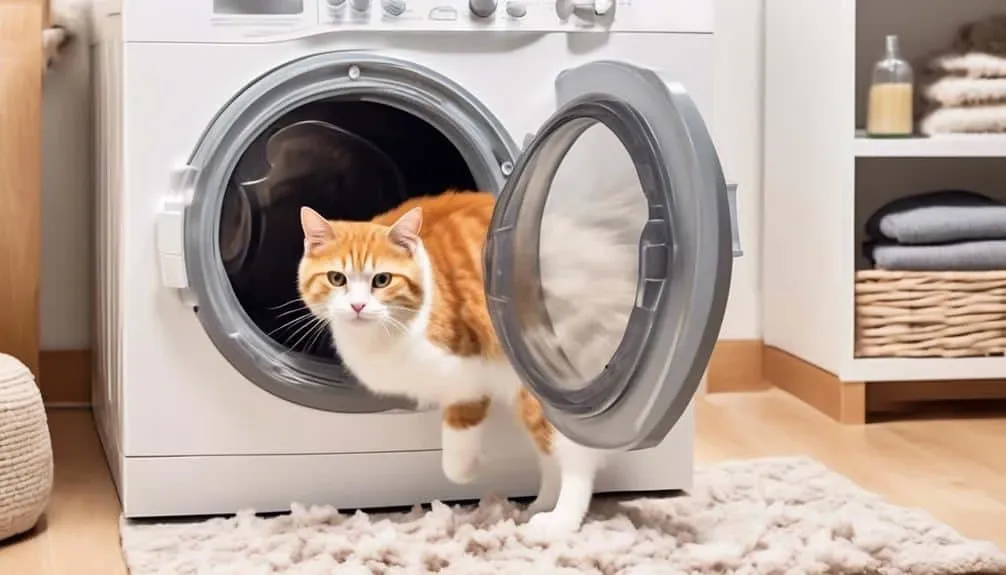The Best Fluffy Pancakes recipe you will fall in love with. Full of tips and tricks to help you make the best pancakes.

Are you constantly battling with fleas infesting your cat's bedding? Imagine a scenario where your furry friend snuggles up on their cozy bed, only to be greeted by an army of tiny, bloodsucking pests. It's a nightmare, but fear not, as there might be a solution at hand – dryers.
In this article, we will explore the effectiveness of using dryers to combat flea infestations on cat bedding. But how exactly do dryers work their magic? And are they truly capable of eliminating all stages of the flea life cycle?
Stay tuned as we delve into the world of flea control, and discover the wonders that dryers can bring to your feline friend's comfort and well-being.
Key Takeaways
- Dryers can effectively kill fleas, eggs, and larvae on cat bedding.
- High temperatures above 40°C/100.4°F and low humidity are necessary to eliminate all flea life stages.
- A 40-minute cycle in the dryer is recommended for effective flea elimination.
- Washing bedding before drying can help drown most fleas, and the heat and tumbling action of the dryer will kill any survivors.
Effectiveness of Dryers in Killing Fleas
Using a dryer to eliminate fleas from cat bedding has been proven to be an effective method due to the high temperatures and conditions it can achieve. To effectively eliminate fleas, the dryer must reach temperatures above 40°C/100.4°F and maintain a relative humidity of less than 50%. These conditions have been shown to kill all life stages of fleas, including eggs and larvae.
It's recommended to run the dryer for a 40-minute cycle to ensure thorough elimination of fleas. Additionally, washing the bedding before drying can aid in flea control. Washing helps drown most fleas, and the heat and tumbling action of the dryer will kill any survivors.
Identifying Fleas on Cats
How can you identify fleas on your cat?
- Fleas are small, dark brown insects that can be seen with the naked eye.
- They have the ability to jump up to 8 inches high despite their small size.
Sub-list 1: Identifying signs of fleas on your cat:
- Cats may eat fleas during grooming, making it difficult to find adult fleas in their fur.
- Instead of adult fleas, you may notice flea dirt, which is digested blood.
- To differentiate flea dirt from normal dirt, collect some and put it on damp cotton wool or white tissue paper. Flea dirt will dissolve, leaving a reddish blood mark.
Sub-list 2: Health risks and prevention measures:
- Fleas can be harmful to cats, causing discomfort, itching, and allergic reactions.
- To prevent fleas on cats, seek advice from your vet and follow their treatment guidelines.
- Use a vet-prescribed flea treatment regularly, such as a spot-on topical treatment or tablet.
- Regularly vacuum floors, skirting, and furniture to prevent flea eggs and larvae from developing.
- Wash cat bedding on a hot wash and tumble dry on a high setting to kill fleas, eggs, and larvae.
Understanding the Flea Life Cycle
The flea life cycle is a complex process that involves multiple stages of development, from eggs to adult fleas. Understanding this life cycle is crucial for effectively protecting cat bedding from flea infestations.
Flea larvae play a significant role in this cycle. The larvae hatch from the eggs and are commonly found in large quantities on cat bedding. They feed off flea dirt, which is digested blood, and undergo several molts as they grow.
Eventually, the larvae develop into pupae and form a protective cocoon. Adult fleas emerge from these cocoons when conditions are favorable.
To prevent infestations and protect cat bedding, it's essential to focus on the elimination of flea larvae through regular washing and drying at high temperatures.
Flea Treatment and Prevention Measures
To effectively control and prevent flea infestations, it's crucial to implement a combination of flea treatment and prevention measures. Here are some flea control methods and vet-prescribed treatments that you can consider:
- Seek advice from your vet and follow their treatment guidelines for effective flea control.
- Use a vet-prescribed flea treatment regularly, such as a spot-on topical treatment or tablet.
To prevent flea infestations:
- Vacuum floors, skirting, and furniture regularly to prevent flea eggs and larvae from developing.
- Use a household flea spray as recommended by your vet.
Importance of Flea Control and Elimination
To effectively control and prevent flea infestations, understanding the importance of flea control and elimination is crucial. Fleas can infest even the cleanest homes, posing health risks to both cats and humans.
It's essential to eliminate fleas from cat bedding as 95% of a flea population resides in the house. Dryers can be a useful tool in eliminating fleas, eggs, and larvae from bedding. High temperatures above 40°C/100.4°F and low humidity can kill all flea life stages, making tumble dryers effective in flea elimination.
Washing bedding before drying can help drown most fleas, and the heat and tumbling action of the dryer will kill any survivors.
Additionally, there are safe and effective flea control methods, such as spot-on topical treatments and tablets, that can help prevent and control infestations. Taking these measures will help protect the health and well-being of both cats and their human companions.
Conclusion
In conclusion, utilizing dryers to eliminate fleas on cat bedding is a scientifically proven and effective method. By achieving high temperatures and low humidity levels, dryers can eradicate all stages of the flea life cycle.
Washing the bedding before drying can further enhance the flea elimination process. While some may argue that using dryers may damage the bedding, it's important to prioritize the health and well-being of your cat by providing a clean and flea-free environment.








